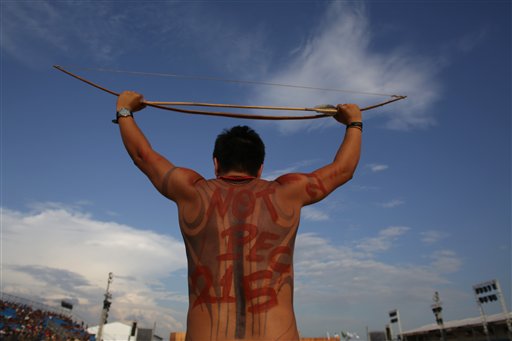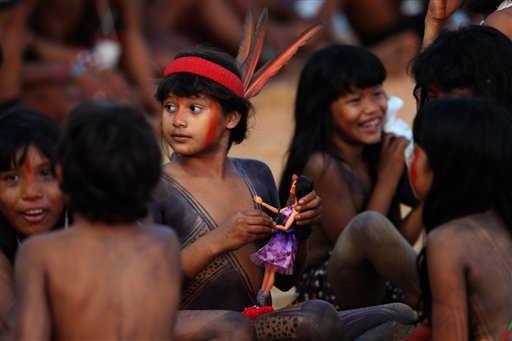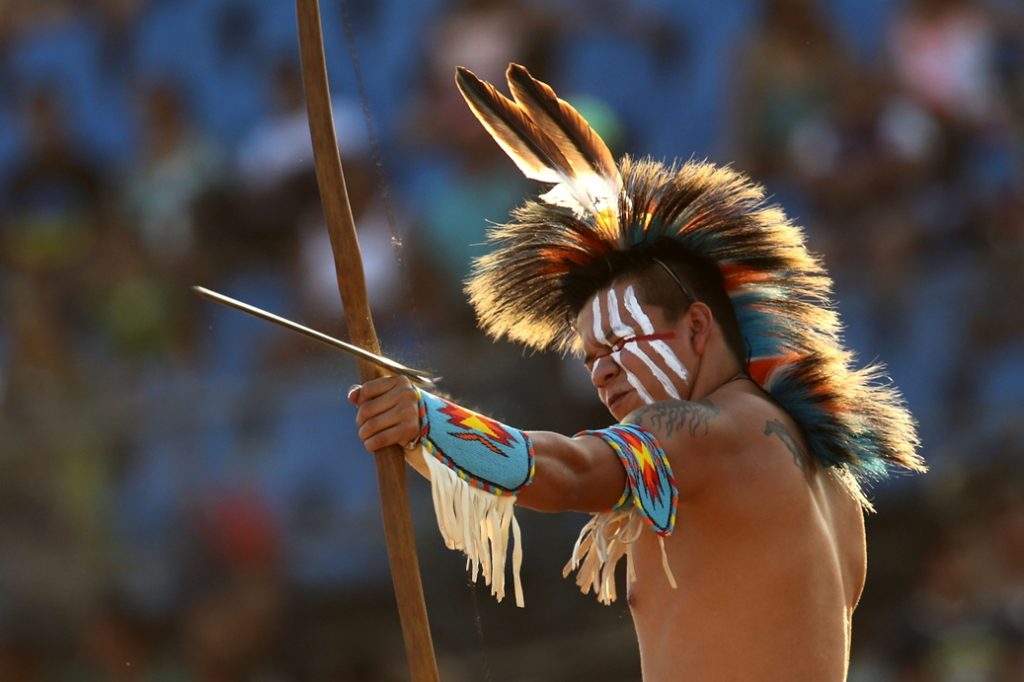Si svolgono su un terreno di trenta acri, non ci sono sponsor, non ci sono telecamere e nemmeno test-antidoping (non ce n’è bisogno) e non bisogna pagare il biglietto d’ingresso. Eppure sono Olimpiadi in tutto e per tutto, quelle che si stanno svolgendo in questi giorni a Palmas, in Brasile – e non è certo un caso che questa bella novità sia nata proprio nel Paese che nel 2016 ospiterà a Rio le altre, più famose, Olimpiadi. Sono i World Indigenous Games e sono aperti a tutte le tribù indigene del pianeta, oggi purtroppo molto esposte al rischio di estinzione. L’ideatore dell’iniziativa è Marcos Terena, co-fondatore insieme al fratello Carlos della Commissione Intertribale brasiliana (ITC). Terena si è ispirato ai nazionali Jogos dos Povos Indígenas (giochi dei popoli indigeni), nati nel 1999. L’organizzazione dell’evento ha visto coinvolti anche il ministero dello Sport brasiliano e la municipalità di Palmas, che per l’occasione ha creato un’Assemblea Straordinaria per assicurare il regolare svolgimento della manifestazione. Palmas, abitata da molti indigeni appartenenti all’etnia Xerente e capitale della regione di Tocantinia, ha infatti accolto dozzine di delegazioni di tribù provenienti da molti paesi del mondo, dal Canada alla Russia, dalla Neozelanda al Sudafrica agli Stati Uniti, dalle Filippine al Paraguay e alla Mongolia. I grandi assenti sono i Krahô, indigeni brasiliani, che hanno accusato i giochi di sfruttare l’identità india e hanno dunque preferito restarsene in disparte.
GUARDA LA GALLERY (12 foto)












Cosa sono le Olimpiadi indigene. «Em 2015, somos todos indígenas», cioè «Nel 2015, siamo tutti indigeni», è il motto che accompagna i giochi olimpici indigeni, apertisi il 23 ottobre, in presenza del presidente brasiliano Dilma Rousseff e di altri dignitari stranieri, e destinati a concludersi il 1° novembre. Le etnie che hanno aderito sono state settanta e gli atleti sono più di duemila, dai sedici anni in su (non esiste un limite d’età massima). Un’affluenza notevole, che fa ben sperare sul proseguimento della neonata tradizione olimpica tribale. Si pensa, infatti, di organizzare i giochi ogni quattro anni e in Paesi ogni volta diversi, come accade per le Olimpiadi che conosciamo. Le discipline in cui gli atleti si stanno cimentando in questi giorni sono sia occidentali che tipicamente indigene. Ci sono competizioni di football, di canottaggio e di atletica, ma anche di tiro con l’arco, di corsa coi tronchi, di lotta e tiro alla fune. Oltre alle gare vere e proprie, si può assistere anche a dimostrazioni non competitive di sport tradizionali, come lo xikunahati, il calcio indigeno, che si gioca usando la testa al posto del piedi. I promotori dell’Olimpiadi hanno inoltre deciso che tutti gli atleti che partecipano ai giochi riceveranno una medaglia: «Nei nostri giochi non si elegge il campione indiano, non c’è intento commerciale, non vendiamo nulla. La medaglia è per tutti, e va alla qualità della vita», ha affermato Marcos Terena.
https://youtu.be/gv_PkewTdoc
Gli organizzatori sono riusciti a mettere d’accordo tutti anche su una questione molto delicata, e cioè l’uso degli strumenti necessari per i vari sport. Ogni etnia, infatti, usa canoe, frecce, archi e lance di diversa grandezza e forma, secondo ciò che prescrive la tradizione. Il capo della delegazione statunitense, David Yarlott, preside del Little Big Horn College del Montana e membro dell’etnia dei Crow, ha affermato che molte tribù considerano gli oggetti che usano come strumenti sacri e dunque non sono contenti, quando si tratta di condividerli con altri. Si è dunque deciso di lasciare scegliere ai partecipanti tra differenti tipi di lance, archi, e via dicendo, messi a disposizione degli atleti dagli organizzatori brasiliani. «Questo per noi va bene, perché fare i controlli all’aeroporto con le lance sarebbe stato un po’ difficile», ha commentato Yarlott.
Non solo giochi, ma anche dibattiti. L’apertura dei giochi è stata preceduta da una tre giorni di festeggiamenti in cui si sono tenuti discorsi e simposi sulle questioni di maggiore interesse per la comunità indigena mondiale, all’interno di una struttura designata a questo scopo e chiamata la “Capanna della Saggezza”, Wisdom Hut. Ma i dibattiti su temi culturali e sociali non sono terminati con l’inizio delle Olimpiadi, anzi. Accanto e oltre alle manifestazioni sportive, è stato previsto un preciso un programma di incontri, in cui ogni gruppo ha potuto mettere sul tappeto i problemi che deve affrontare nel proprio Paese, come quello della malnutrizione, dell’alcolismo e della prostituzione. C’è anche un Forum sociale per i popoli, uno spazio dedicato alle attiviste per le donne indigene e sono previste mostre e lezioni. La maggior parte degli eventi sono gestiti dagli indigeni stessi e, nel complesso, si è istituito un festival interculturale e sociale che, senza retorica, può essere considerato il primo di questo tipo, almeno per numero di etnie rappresentate.
GUARDA LA GALLERY (12 foto)












Olimpiadi ecosostenibili. Niente deve andare sprecato, per i popoli più antichi della Terra, anche quando bisogna di far festa e si sarebbe portati a scialacquare risorse e materiali. Le strutture costruite per i giochi, incluse le residenze degli atleti, sono state perciò realizzate con materiali ecosostenibili e riciclabili. Inoltre, sono state piantati centinaia di nuovi alberi per sostituire quelli intagliati per fare le canoe e altro materiale sportivo. «I bianchi non pensano in questo modo. Comprano una cosa, ne comprano un’altra, e poi la buttano nella spazzatura», ha detto Carlos Terena.
L’importanza di stare insieme. Le popolazioni indigene, oggi, sono in genere proprietarie della terra in cui risiedono, ma non delle risorse e per questo motivo sono poverissime. L’avanzata delle città, delle strade e delle ferrovie, inoltre, toglie sempre più spazio a popoli abituati a vivere sparsi in foreste, praterie, boschi. Le sfide che i popoli africani, americani e asiatici devono gestire sono molto simili e riguardano direttamente la sopravvivenza delle loro tradizioni, della loro cultura e lingua. Lo scopo delle Olimpiadi indigene è quello di creare dei legami duraturi di amicizia tra le etnie che vivono ai capi opposti del mondo, legami di solidarietà e di mutuo aiuto. Come ha affermato Reginaldo Tapirapé, un capo dei Tapirapé che vivono nel Brasile centromeridionale: «Dimostreremo che la nostra lingua è viva, che la nostra cultura è viva, che i nostri corpi sono vivi».


